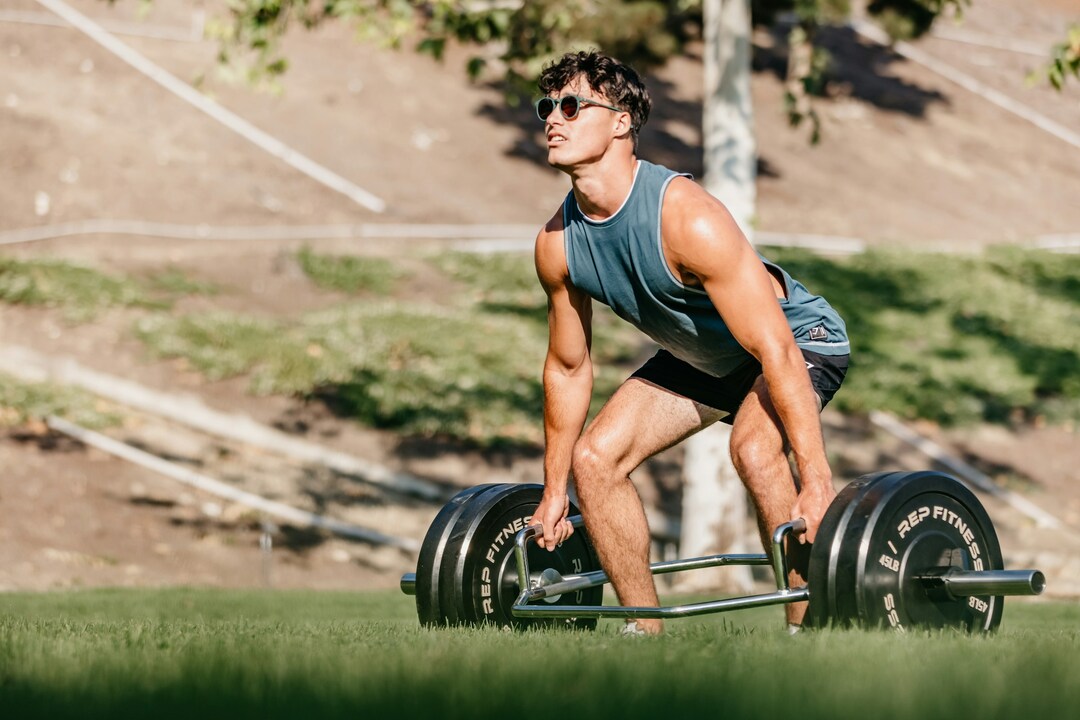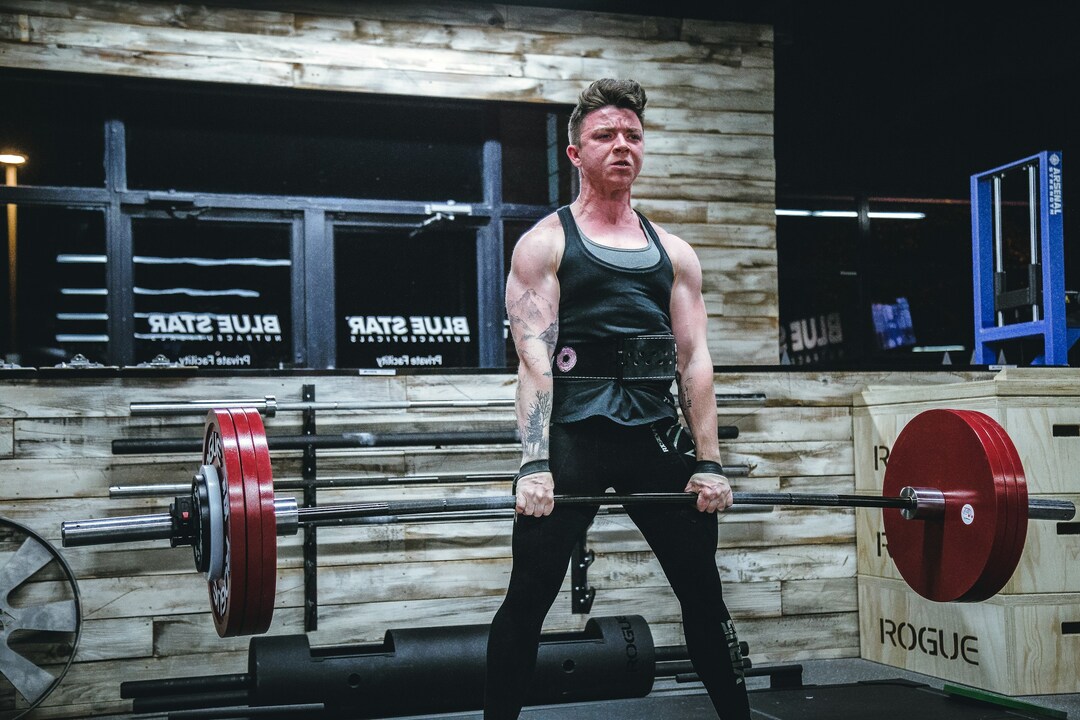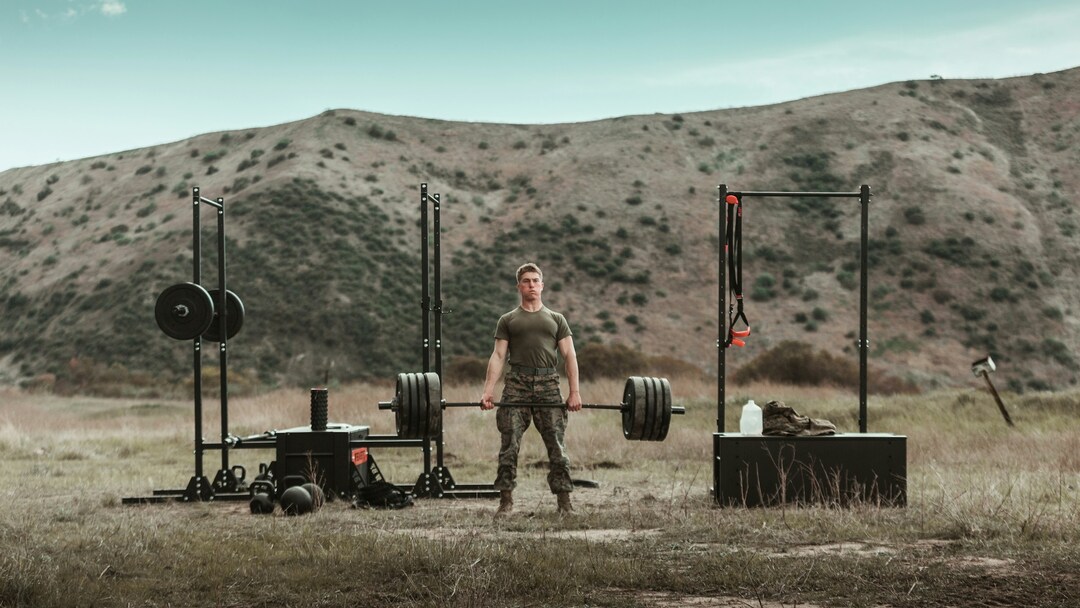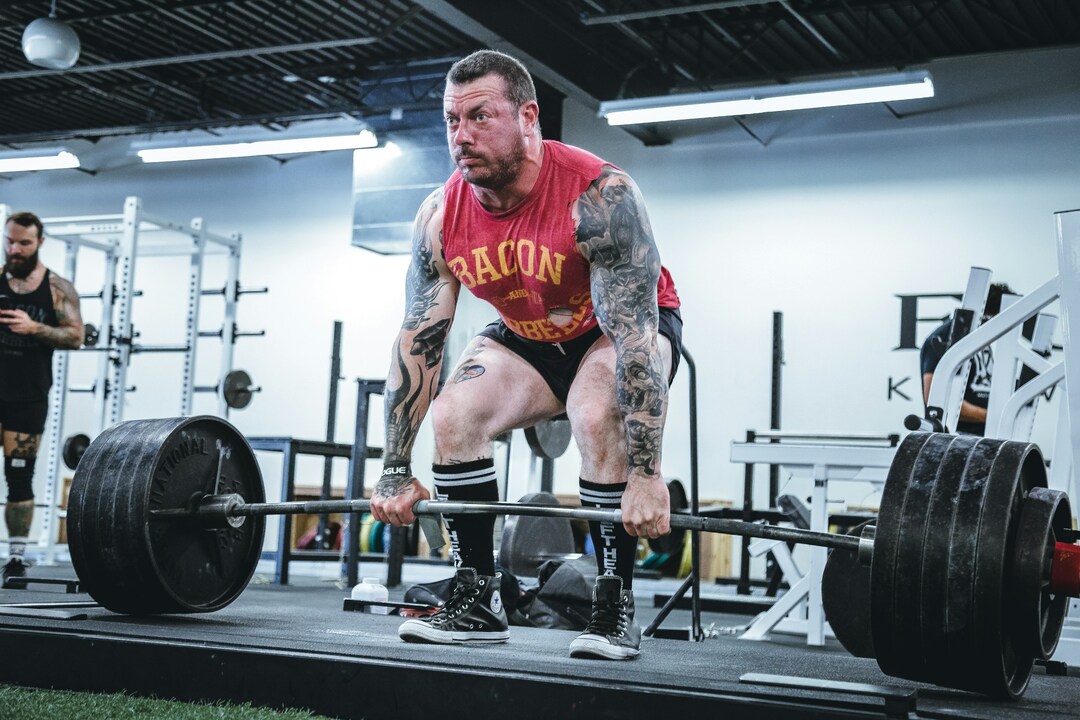What is the Average Male Deadlift?

Discover the average male deadlift by age and experience. See how your numbers stack up and learn what affects strength levels.
Scrolling through Best Fitness Apps and gym threads, you may find wildly different numbers and wonder what a regular deadlift looks like for a man of your weight and experience. Is a 300-pound one rep max impressive for your body weight, or should you judge progress by relative strength and lifting standards for beginner, intermediate, and advanced lifters?
This guide breaks down deadlift standards by body weight and training age, shows typical one rep max ranges, and explains how technique, muscle mass, and steady progression shape your strength levels. Want precise numbers and simple steps to improve form and track gains?
GetFit AI's AI fitness app turns those numbers into a clear plan, offering personalized 1RM estimates, training plans, and form tips tailored to your body weight and experience so you know what to aim for.
Summary
- Deadlift expectations should be class-specific rather than universal, with a novice male average around 225 lb per Strength Level and numbers shifting up with bodyweight and training age.
- Relative strength matters more than absolute pounds, with an intermediate male standard of around 315 lb and advanced benchmarks at 405 lb. Therefore, a raw number means very different things at 150 lb versus 240 lb.
Starting strength sets the slope of progress, as the average untrained person lifts about 135 pounds, according to Everyday Health. This explains why timelines to reach 225 pounds vary widely. - A practical 12-week progression is divided into three blocks, using 65 to 75 percent for sets of 6 to 8 in weeks 1 to 4, 75 to 88 percent for sets of 3 to 5, and microloading of 5 to 10 pounds for steady gains.
- A 300-pound deadlift is a significant milestone that sits near the intermediate benchmark of 315 pounds. Still, its value depends on repeatability, consistent recovery, and functional carryover rather than the headline number alone.
- Technique and recovery should guide increases; for example, only add weight after completing two quality sets at your target rep range and confirm thresholds across three sessions in two weeks to avoid fatigue-driven breakdowns.
- This is where GetFit AI fits in; the AI fitness app addresses this by converting class-specific benchmarks and recovery markers into personalized 1RM estimates and stepwise deadlift progressions.
What is the Average Male Deadlift by Body Weight?

The average male deadlift does not have a single number; it varies with bodyweight and training experience, so use class-specific benchmarks instead of one-size-fits-all comparisons. Compare your lift to that of your peers in your weight class and experience band, then develop a progression that preserves technique and recovery while gradually increasing the load.
How do bodyweight and experience change what a “good” lift looks like?
Absolute pounds rise as bodyweight goes up, but relative strength, how much you lift for every pound you carry, rarely moves in a straight line. For baseline context, the average male deadlift for a novice lifter is 225 lb, according to Strength Level. As lifters log consistent training and time under the bar, the standard shifts upward, which is why an intermediate male lifter can deadlift 315 pounds, according to Strength Level. However, that number means different things to someone who weighs 150 pounds versus someone who weighs 240 pounds.
Why does this comparison frustrate so many people?
This pattern appears among beginners in military service and athletes rehabbing injuries: they compare raw numbers, become discouraged, and either stall their progress or rush into heavier loads. The emotional toll is real, a mix of envy and impatience that eats motivation. When recovery is slow, as often happens after spine procedures, the desire to return to previous numbers can prompt lifters to adopt unsafe loading strategies rather than pursue smart, incremental gains.
What’s the safer, more innovative approach to setting targets?
Aim for phased progress, where technique and recovery gate increase. Use a training max set that is well below your actual one-rep max, program volume and intensity over weeks, and track simple recovery markers like sleep quality and soreness. Progress becomes predictable when you treat loading as a variable to be tuned, not a ceremony to be rushed.
Most lifters compare numbers and accept the hidden cost, then look for shortcuts.
Most lifters handle benchmarks by scanning leaderboards and copying programs because it is quick and feels objective. That familiar approach works for short bursts, but it breaks down as fatigue, mobility limits, and life stressors accumulate, leading to stalled progress or injury. Solutions like GetFit AI translate elite athlete routines into stepwise, personalized deadlift progressions that adjust load, volume, and accessory work around individual recovery signals, keeping progress steady without sacrificing safety.
How should you apply bodyweight-based standards in practical situations?
Treat the standard numbers as reference points, not prescriptions. If you are below your class median, prioritize technique, frequency, and accessory posterior chain work for 8 to 12 weeks, then retest. If you are near or above the median, shift to targeted strength blocks with conservative intensity ramps and more deliberate deloads. Think of training like tuning an engine; minor adjustments over time produce the most reliable gains.
That simple benchmark logic looks straightforward, but the next question exposes a surprising fault line in how most people interpret those numbers.
Deadlift Standards For Men
Body Weight (lbs): 114
- Untrained: 95 lbs
- Novice: 180 lbs
- Intermediate: 205 lbs
- Advanced: 300 lbs
- Elite: 385 lbs
- World Record: 594 lbs
Body Weight (lbs): 123
- Untrained: 105 lbs
- Novice: 195 lbs
- Intermediate: 220 lbs
- Advanced: 320 lbs
- Elite: 415 lbs
- World Record: 633 lbs
Body Weight (lbs): 132
- Untrained: 115 lbs
- Novice: 210 lbs
- Intermediate: 240 lbs
- Advanced: 340 lbs
- Elite: 440 lbs
- World Record: 629 lbs
Body Weight (lbs): 148
- Untrained: 125 lbs
- Novice: 235 lbs
- Intermediate: 270 lbs
- Advanced: 380 lbs
- Elite: 480 lbs
- World Record: 704 lbs
Body Weight (lbs): 165
- Untrained: 135 lbs
- Novice: 255 lbs
- Intermediate: 295 lbs
- Advanced: 410 lbs
- Elite: 520 lbs
- World Record: 759 lbs
Body Weight (lbs): 181
- Untrained: 150 lbs
- Novice: 275 lbs
- Intermediate: 315 lbs
- Advanced: 440 lbs
- Elite: 550 lbs
- World Record: 891 lbs
Body Weight (lbs): 198
- Untrained: 155 lbs
- Novice: 290 lbs
- Intermediate: 335 lbs
- Advanced: 460 lbs
- Elite: 565 lbs
- World Record: 880 lbs
Body Weight (lbs): 220
- Untrained: 165 lbs
- Novice: 305 lbs
- Intermediate: 350 lbs
- Advanced: 480 lbs
- Elite: 585 lbs
- World Record: 952 lbs
Body Weight (lbs): 242
- Untrained: 170 lbs
- Novice: 320 lbs
- Intermediate: 365 lbs
- Advanced: 490 lbs
- Elite: 595 lbs
- World Record: 970 lbs
Body Weight (lbs): 275
- Untrained: 175 lbs
- Novice: 325 lbs
- Intermediate: 375 lbs
- Advanced: 500 lbs
- Elite: 600 lbs
- World Record: 948 lbs
Body Weight (lbs): 319
- Untrained: 180 lbs
- Novice: 335 lbs
- Intermediate: 380 lbs
- Advanced: 505 lbs
- Elite: 610 lbs
- World Record: 939 lbs
Body Weight (lbs): 320+
- Untrained: 185 lbs
- Novice: 340 lbs
- Intermediate: 390 lbs
- Advanced: 510 lbs
- Elite: 615 lbs
- World Record: 1,014 lbs
Related Reading
- Best Fitness Apps
- How Many Pull Ups Should I Be Able To Do
- Average Bench Press By Age
- Average Grip Strength Male
- Average Bench Press
- How Much Does A Bench Press Bar Weigh
- Average Male Bench Press
- How Much Can The Average Man Bench Press
Can the Average Man Deadlift 225?

Yes, many men can reach a 225-pound deadlift, but it is not a universal baseline — it depends on starting strength, training quality, and how well you manage technique and recovery. With focused programming and steady progression, a realistic path to that number exists for a broad range of men, but the timeline and methods vary.
How much does starting strength matter?
The reality is that raw starting capacity sets the slope of progress. For context, Everyday Health states, "The average untrained man can lift about 135 pounds." That figure explains why two lifters on the same program can have very different calendars for hitting 225, because one is starting closer to the goal physically and neurologically.
What physical factors speed the climb to 225?
Body structure, not just bodyweight, changes the work. Shorter femurs and longer torsos often make the deadlift mechanically easier, while long legs can demand different hip mobility and bar path work. Tendon health, prior athleticism, and even how you absorb fatigue control how quickly volume turns into strength. Practically, someone with a decent posterior chain and consistent training frequency will progress more linearly than someone rebuilding from prolonged inactivity.
What does a practical 12-week progression look like?
Treat it as three blocks. Weeks 1 to 4, build volume on the movement and its variants with sets of 6 to 8 at 65 to 75 percent of a recent rep max, adding total weekly tonnage by 5 to 10 percent. Weeks 5 to 8, shift to heavier work, sets of 3 to 5 at 75 to 88 percent, increasing intensity while trimming accessory volume. Weeks 9 to 12, test heavier singles while keeping recovery higher, using planned deload sessions and focused mobility work. A helpful rule I follow, taught by coaches and repeated across programs, is only to add weight when you can complete two quality sets at your target rep range without technique breakdown. Then, add small increments of 5 to 10 pounds.
Which assistance and recovery choices actually matter?
Build the posterior chain deliberately, not randomly. Romanian deadlifts, heavy hip hinges from blocks, single-leg Romanian variations, barbell rows, and loaded carries transfer directly to the deadlift. Prioritize sleep and protein, because neural recovery is where heavier singles are earned. Treat soreness as data, not drama; persistent joint pain is a signal to change angles or volume, not an invitation to grind.
Why copying elite programs usually backfires, and what fixes it?
Most lifters apply elite athlete protocols to their own lives because that approach feels authoritative and straightforward. That familiar approach works briefly, but the hidden cost manifests as creeping fatigue, stalled lifts, and avoidable injuries when volume or intensity exceeds personal recovery capacity. Platforms like GetFit AI translate elite athletes’ routines into stepwise, personalized deadlift progressions that adjust load, volume, and accessory work based on individual recovery signals, allowing users to follow proven templates while avoiding standard failure modes.
How do you know when to push for a big jump?
Look for consistent technical control under heavier sets, rising daily readiness, and repeatable progress across several weeks. Concretely, if you can perform three sets of five at roughly 80 percent of a goal lift with no technical drift and your recovery metrics are stable, adding weight in small steps is reasonable—frame progress as a series of reliable micro wins, not dramatic leaps.
Think of a deadlift program like tuning a stereo: minor, precise adjustments to bass, treble, and balance get you to clarity, while blasting the volume in hopes of more bass usually ruins the speakers.
That simple benchmark starts to feel different once you see how those minor adjustments stack over time, and the next question about what 135 really means gets a lot more interesting.
Is Deadlifting 135 Impressive?

Deadlifting 135 pounds is modest for most adult men with training experience, but it can be a meaningful and revealing milestone when you consider the context beyond the raw number. What matters more is how you achieve 135, how you manage it, and what it reveals about your readiness for safe, sustained increases.
What does performance quality tell you that the weight does not?
If the bar moves smoothly, your hips lock out without lumbar rounding, and you can repeat clean reps across multiple sets, that 135 is functionally sound. Those technique markers show motor learning and tissue resilience, which are the real currency of progress. Conversely, a jerky single rep at 135 says more about a gap in stability or neuromuscular control than it does about strength.
When does 135 signal real progress rather than a number to brag about?
When we take beginners through focused 8- to 12-week blocks, the pattern is clear: hitting multiple working sets with consistent form at a fixed load predicts faster, safer jumps in capacity than chasing singles. This pattern appeared repeatedly across different clients and age brackets, where the same disciplined pacing turned 135 from a one-off into a dependable training weight that could be built on.
How should you judge 135 compared to wider standards?
For context, the average male deadlift for a novice lifter is 225 lb, according to Strength Level. And at the far end of the scale, an advanced male lifter can deadlift 405 lb, per Strength Level. Those anchors help you place 135 on the continuum, but they do not replace individualized progress markers.
Why the habits around numbers quietly sabotage progress
Most lifters handle benchmarks by copying headline pulls and chasing one-rep numbers because it feels objective and fast. That approach works in the short term, but as volume, life stress, and mobility issues accumulate, it compromises recovery and technique. The hidden cost is predictable: stalled gains, frustration, and avoidable soft tissue pain.
How can more innovative tools change that familiar pattern?
Most people program by looking at a target number and doubling it, which is a familiar and straightforward approach. As training complexity grows, that method creates mismatched intensity and recovery breakdowns. Platforms like AI fitness apps translate proven athlete templates into stepwise, personalized deadlift progressions that adjust load, volume, and accessory work based on individual recovery signals, keeping progress steady while reducing injury risk.
What to watch for before you add more weight
Use movement cues based on repeatable percentages: a repeatable tight hip hinge at the start of the pull, no change in bar path across sets, repeatable breathing and bracing, and recovery markers like sleep and training readiness that remain stable. If those anchors are present, you have cause to add small increments. If they wobble, treat 135 as a diagnostic load to program around, not to be rushed past.
A quick image to hold onto
Think of 135 as a tuning fork; when it rings true across sets, it amplifies the rest of your training, but when it buzzes inconsistently, it exposes where you need to fix resonance.
That simple milestone feels different when you see what it reveals about readiness and risk, and the next question about 300 pounds exposes a surprising fault line in how people measure strength.
Related Reading
- Bench Press Standards
- Do Pull Ups Work the Chest
- Symmetric Strength
- Average Deadlift Weight
- Grip Strength Norms
- 1 Rep Max Chart
- Good Bench Press Weight
- Weightlifting Standards
Is Deadlifting 300 lbs a Lot?

Yes. A 300-pound deadlift is a meaningful milestone for many men because it represents a clear threshold of usable posterior chain strength. Still, its real value depends on how you get there and how repeatable the lift is under controlled conditions. Context matters more than the headline number; what turns 300 into progress is consistency, recovery, and technical control.
Who should call 300 a win?
For lifters who train consistently and prioritize technique, 300 is often a hard‑earned marker of above‑average strength. For quick orientation, the average male deadlift for a novice lifter is 225 lb, according to Strength Level. That puts 300 clearly beyond beginner territory, but not yet at the higher competitive bands.
What does reaching 300 actually require?
Physically, it is not just about having bigger muscles; it is also about better coordination between the nervous system and muscles, tendon resilience, and a durable grip. You need repeated exposure to heavy loads so motor units recruit efficiently, and you need accessory work that strengthens the lumbar erectors, hamstrings, and hip extensors without inflaming weak spots. Practically, that means targeted heavy triples, speed tension sets, and progressive overload applied in small, measurable increments while monitoring sleep, soreness, and bar speed.
Why chasing the number alone fails too often
Most lifters chase round numbers because they feel objective and motivating. That familiar approach works at first, but as fatigue accumulates, technique degrades, recovery slips, and minor weaknesses get amplified into pain or stalled progress. Solutions like GetFit AI translate elite athlete templates into stepwise, personalized deadlift progressions, adjusting volume, intensity, and accessory emphasis based on individual recovery signals, allowing users to pursue a 300-pound pull without sacrificing long-term durability.
How should you judge whether 300 is significant for you?
Treat 300 as a milestone, not a final destination. Look for three repeatability signals: multiple heavy sets with stable bar path, consistent recovery and readiness scores across weeks, and functional carryover such as loading heavy grocery bags or deadlifting from awkward positions without strain. To place it on the spectrum, an intermediate male lifter can deadlift 315 lb, so 300 sits close to the intermediate threshold. It should be judged by how reliably you can reproduce it, not by whether it sounds impressive.
Think of a 300-pound pull like tuning a musical instrument; the number is the note, but the absolute mastery shows when the instrument stays in tune through the song.
That simple milestone sounds decisive, but the next question reveals a deeper threshold that most people often overlook.
Is a 315 Deadlift Good?

Yes. Hit cleanly and repeatably, that load signals more than brute force; it signals neural efficiency, durable posterior chain, and a grip that does real work under fatigue. The meaning it holds for you depends on transfer, reproducibility, and whether the lift aligns with your goals.
What does that weight tell you about relative strength?
Pattern recognition: when a raw number appears impressive on paper but fails to translate into daily tasks, the missing piece is relative strength and repeatability. According to All About Powerlifting, "A 315-pound deadlift is approximately 1.5 times the body weight of an average male lifter." That ratio explains why the same single pull can feel like a breakthrough for one lifter and only a stepping stone for another. Look for how the load affects your movement quality across sets, not just the ego of a single maximal rep.
How do you know if 315 is a valuable milestone for your life and sport?
Specific experience: When coaching lifters who seek functional strength, we stop treating one-rep numbers as the sole measure and begin testing repeatability over time, using indicators such as consistent bar speed, identical bar path on heavy doubles, and the ability to perform controlled carries afterward without breathless collapse. If those signals are present, the number corresponds to usable strength; if they are not, the lift is a vanity metric that will frustrate you in real-world tasks, such as extended carries or manual labor.
Most people train familiarly, and that creates a hidden cost.
The familiar approach is chasing max singles and copying headline programs because it feels efficient. What happens next is predictable: fatigue fragments technique, small weak links show up as pain, and functional tasks still fail. Solutions like GetFit AI translate elite athlete templates into stepwise, personalized deadlift progressions that adjust load, accessory work, and recovery based on individual readiness, so users achieve the transfer they want without piling on unreadable volume.
What training levers actually move a heavy, usable deadlift?
Problem-first: technique alone does not create durability, and volume alone does not create maximum output. The levers that matter are targeted: high-tension heavy triples to train the nervous system, heavy holds and mixed-grip or hook-grip practice to build grip durability, Romanian and block pulls to load different joint angles, and loaded carries for metabolic and positional tolerance. Use microloading and autoregulation so you add five to ten pounds when you truly maintain form, not because the calendar says it is time.
Why the emotional side matters
Pattern recognition: Frustration often arises from a mismatch between gym numbers and real-life needs, such as struggling to carry a partner despite lifting with decent intent. That feeling is exhausting and demotivating because the body learns to respond to the stress you experience most often. Reframing training around repeatable strength and specific transfers restores momentum and confidence far more quickly than chasing around numbers.
A brief tool you can use right now
Constraint-based advice: test a heavy threshold over three sessions within two weeks, using doubles or triples rather than a single attempt. Monitor bar speed and recovery scores, and only add load when those measures remain stable. When this rule holds, progress is reliable, and the lift becomes functional instead of fragile.
Think of hitting that mark like building a bridge, not celebrating the first car that crosses it; the proof is in whether traffic continues to flow.
The following section will reveal something you may not have expected about athletes and personalization.
Make Your Favorite Athlete Your Fitness Trainer | Try GetFit AI's AI Trainer App for Free Today 💪
If you want deadlift progress that actually holds up week to week, consider GetFit AI; I know it’s exhausting to juggle technique, recovery, and conflicting advice, and this app turns elite athlete templates into personalized, recovery-aware progressions so you stop guessing and start building repeatable strength. With over 10,000 workouts completed using GetFit AI, 90% of users reported improved fitness levels within 3 months. You can try a structured, affordable approach that fits your schedule and delivers clear, actionable feedback.
Related Reading
- Best Hiit Workout App
- Best Free Workout Apps
- Best Workout Tracker App
- Average Bench Press By Age 16
- Average Deadlift Weight Kg
- Best Workout Apps
- Best Calisthenics Workout App
- Best Gym Workout App
- Average Deadlift Weight For Male
- Average Bench Press Kg By Age



.png)











